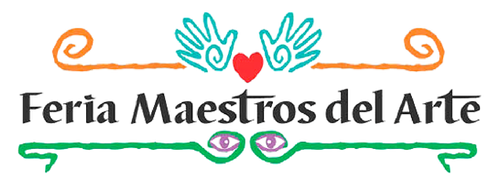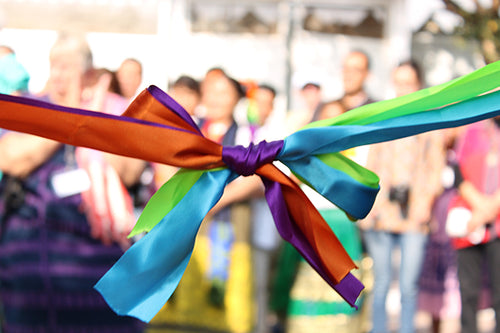
Coopertiva Bii Daüü, Teotitlán del Valle, Oaxaca
The very best of Mexican handicrafts is represented in the fine handwoven carpets and rugs produced in Oaxaca, Mexico. The most important of the Central Valley Oaxacan towns producing excellent handcrafted woven wool products is Teotitlán del Valle.
The Natural Dye Weaving Cooperative was formed in 2002 and consists of 16 weavers. Most weavers in Teotitlan del Valle work with both natural and chemical dyes. However, the weavers in this cooperative are dedicated to working only with natural dyes.
Bii Daüü uses the Zapoteca model of a balanced life where the family is the nucleus of life. They believe in co-existing with nature using techniques and providing services that respect what nature gives us.
Bii Daüü is a "shared economy," the members working together with equal distribution of profits and benefits gained from their cooperative efforts. They never take more from nature than they are able to use immediately and believe their alternative or "natural" techniques give back to the earth, rather than take from it.
Each member is recognized and respected for the ideas he/she brings to the cooperative. The exchange of experiences, qualifications and work with other organizations makes the group stronger and able to fulfill their objectives. This ability to work as a cohesive group gives each member confidence and commitment to excellence.
Teotitlán del Valle is a Zapoteca. Its inhabitants have been dedicated for centuries to working with textiles. In the eighties, as a result of the increase in the sale of textiles from this area, farmers chose to change their lifestyles (where they once were only farmers or raised animals) and devote their lives to weaving. It is the men who usually do the actual weaving while the women devote themselves to thread production and dyeing - they have returned to the customs used at the height of the Zapotec culture.
Over the years, The Natural Dye Weaving Cooperative believes sales and the quality of the weaving done in Teotitlan del Valle have declined due to factors such as: The monopolizing of the market by a few retailers, massive production without quality control, and the adoption of the use of synthetic dyes. As a result, weavers who use natural dyes cannot sell their work for what it is worth - others who use synthetic dyes can sell for less and for this reason, sell more than the natural weavers.
This situation began to cause problems within the community and so the cooperative was formed to unite their efforts and objectives and improve their sales and the quality of their products. If cooperatives are run properly, the artisans can do much better financially than if they try and work separately on their own. However, several of the weavers had not had good experiences with other cooperatives and they were reticent to join this guild. The decision to manage the cooperative as a business won them over and the Center of Textile Art Zapoteco Bii Dauu was formed in May of 2004. It has 21 weavers, 8 women and 13 men, all from Teotitlán del Valle. Bii Dauu is distinguished by their elaborate designs and weaving styles and the fact that all their weavings are made from yarns dyed naturally.
Their mission is to work with equality and fairness to achieve the best quality in all their products. The cooperative includes health care and other social and cultural advantages the weavers have not had before working on their own.
Bii Dauu works using only natural dyes. The dyeing processes are done in an area equipped with solar heating used to heat water, an ecological furnace that saves in the use of firewood, run-off water is put into a storage pool and reused, and all containers used for washing, dyeing and rinsing are made of natural earth products. The range of colors used in natural dyeing is immense. Colors are taken from plants, insects and minerals.
With the introduction of chemical colorants and its lower cost, there became a shortage of plants and cochinilla in Teotitlán because nobody was harvesting and caring for them. Bii Dauu proposed a solution - they would farm their own plants and cochinilla.
Bii Dauu created an orchard solely for the raising of fruit, medicinal plants, plants used for dyes, and vegetables. Working with a government agency to ensure the orchard is completely organic enables them to certify this on their finished woven products.
Seed Plants used for Dyes:
Pericón (tagetes lucida) A plant used for dye and medicinal uses formerly collected in the wild, it is now farmed in the orchard.
Marush A plant threatened by plague has been brought back into a healthy existence in the orchard.
Nopal de castilla (opuntia ficus indica) A type of cactus used to grow cochinilla (dactylopius coccus), a small parasite that lives on the nopal. When crushed it produces a beautiful red color.
Granada (punica granatum) The pomegranate tree.
Nogal (walnut) (guglans regal) Tree whose leaves produce a very dark dye.
Muitle (spicigera justice) Plant used in combination with indigo to obtain shades of blue.
Attending: Procoro Ruiz Gutierrez
Feria Maestros del Arte 2013, 2024
ARTIST INFORMATION
Iturbide # 32
Teotitlán del Valle, Oaxaca 70420, México
(951) 524 4452
artextil_zapoteco@yahoo.com.mx

